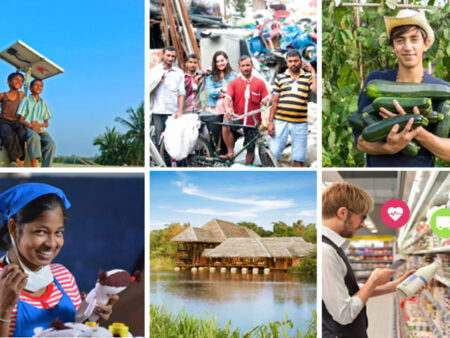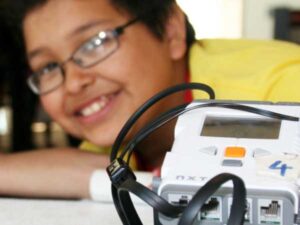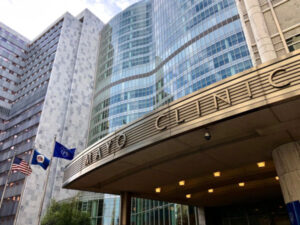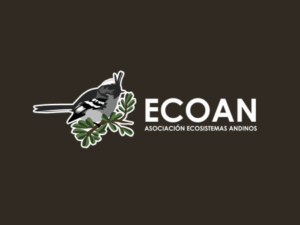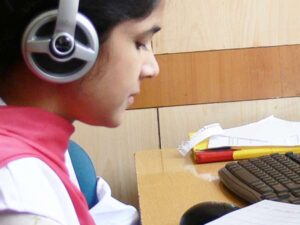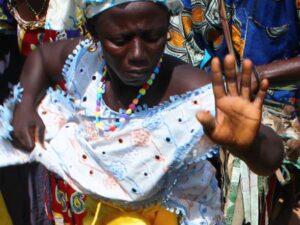Good Market is a community of social enterprises and other businesses dedicated to putting people and planet over profit.
Amanda Kiessel of Good Market spoke with Lissa Harris on February 14, 2023. Click here to read the full conversation with insights highlighted.
Lissa Harris: Can you introduce yourself and describe the problem that you’re addressing and your approach to responding to it?
Amanda Kiessel: I’m Amanda Kiessel. I’ve spent the last 20 plus years based out of Asia, mostly Sri Lanka, and I’m involved in something called Good Market that is set up in a way to enable infrastructure. There are many different networks using it. So Good Market is the main story and probably what we’ll focus on today, but there’s a lot of sub stories that also involve other Skoll partners. So hopefully we can get into that as well. One of those is called Catalyst Market, another initiative supported by Good Market.
The problem we’re focused on is our current economic system. Our current economic story that we humans have come up with is that our purpose is to maximize profit, to accumulate finances, to continuously grow. And that is at the root of so many of the challenges that we’re facing, whether it’s climate or inequality or hunger or racism or across the board, it’s at the root of so many problems. So that’s the big picture challenge that we’re dealing with.
There’s a subset of that problem that we’re specifically focused in on, and that is that we have this incredible movement all over the world of people choosing a different story, of people choosing in their own personal lives and in the work that they’re doing to put people and planet first over profit maximization. We’re creating a new story. We’re creating a new system together. You have both individuals and organizations that are choosing to work in a different way, and when you choose to work in a different way, you also choose to partner with others, either when it’s trade or services or collaboration that are also part of this movement.
One of the challenges we have is, because it’s emerging bottom up, it’s still fragmented. So you can’t fully see it all of the time because it’s divided up based on what sector people are in, maybe you have the slow fashion revolution community or people working on regenerative agriculture or renewable energy, but they all have the same root purpose.
It’s divided by how we’re registered. Are you a non-profit, a cooperative, a B Corp, or how are you certified? And also very much by language and region. And I think that’s also a big part of having spent 20 years in Asia, you can really feel the fragmentation by language and region. You’ll have amazing things coming up in a place, but maybe they’re not heard of because they’re not in English or it’s not from a particular community. The whole purpose of what we’re trying to do is to make the movement more visible and to make it easier for everyone to find and to connect with each other so we can help speed up this transition. That’s the big picture.
Lissa Harris: How specifically does your work facilitate making these connections between organizations or people that are engaged with having other priorities besides maximizing growth?
Amanda Kiessel: The heart of it is we have community-owned curation processes and a crowdsourced monitoring system. So what that means is there’s minimum standards for every sector so that it works across. We have everything from artists to people doing all different types of work. There’s minimum standards for every sector and a free online curation process. If a group is approved and has a public profile on the site, there’s a crowdsource monitoring system that everybody’s involved in helping maintain.
I had a background in third party certification. I’ve done a lot of work on organic and fair trade, and that’s really valuable in certain contexts, but it’s also the tip of the iceberg. The groups that have this third party certification tend to be able to afford it, they’re working in certain markets, it doesn’t include everybody. So the idea here is if you have third-party certification, fantastic. You can include it, you can search by it, that’s great. But this is a way of being able to recognize everyone that’s doing this work, including ones that might not be English speaking or don’t have the resources to pay for third-party certification, or come from more marginalized communities, they can be visible as well. You don’t have to be legally registered. You could be a mutual aid group or a voluntary group or things like that.
So that’s the heart of it, and then I think there’s a whole story of how that all started and where that first got tested. But then the second piece is, it’s set up as a digital commons. So it’s shared infrastructure, kind of like Wikipedia would be, but instead of for knowledge, it’s for building the new economy. The shared infrastructure part is to make it easier for groups to find and connect and it’s set up to support existing networks and community groups.
There’s a main directory and marketplace for everybody, but if you are somebody that works with a lot of these different kinds of initiatives, you can have your own homepage with your directory, your community, your logo and the story of your community and a marketplace for your community. A lot of the outreach is happening through that. It’s networks wanting to get their community members on, networks wanting it to be translated into their own local language and networks wanting to use it as a tool. So the curation and the shared infrastructure are at the heart of it.
Lissa Harris: And you have curators for different market sectors or different industries?
Amanda Kiessel: We actually did all of this in-person and tested the concept in-person for years before it went online. We did weekly meetings, [had paper] applications in three different languages. So the way that it works is it’s a single form, but you see different questions depending on what sector you select or how you answer previous questions.
So you might get additional follow-up questions for something, and that makes the review process a lot easier because it still requires a human to double check. But it’s pretty easy to flag whether something meets the minimum standards or not. So the curation is designed to be kind of a lightweight process that everyone was part of co-creating and has the process to keep evolving over time. So it’s a single form.
Lissa Harris: Who are the main beneficiaries of your work? Who are the typical organizations or groups or individuals that benefit from it? And how specifically do they benefit from this community that you’re building?
Amanda Kiessel: We use the word enterprise to describe all of the different groups that have a profile page, but some of them are non-profits trying to have a self-sustaining model. Some are not registered, some are companies trying to be more responsible. So I’d say that the core group is these kinds of initiatives around the world. And for them, they’re looking to connect with each other, either for support systems or trade or to be able to collaborate if they’ve got a shared problem, that kind of thing.
This was not expected, but there’s very much an element of individuals that are feeling concerned about what’s going on in the world and trying to figure out what they can do to make a difference. So in some cases it’s them wanting to join up with an existing group or they have an idea and they want to start something on their own. And this is kind of an easy way that they can start to get involved. So there’s an individual element.
So it’s enterprises, individuals, and then the big thing now is very much the networks. So whether you have a community of place like your own local community and you’re trying to have more collaboration with all these different types of groups, or if it’s more of a community of practice. So for example, the World Fair Trade Organization has a network page or the Social Enterprise World Forum. There’s a lot of different networks that have a shared purpose or are working on a challenge together and then they use this as a tool. So it’s enterprises, individuals, and networks that are all trying to move this work forward.
Lissa Harris: It must get complicated, having entities of different shapes and sizes all in the mix?
Amanda Kiessel: I would say that’s the part of what [makes] the intervention that we’re trying to support. Rather than telling people that we’re all part of the same movement, this is a way of showing. And I’ve had the experience a lot in the past that you might have people coming from what would be considered the core or the center, not recognizing all of the things that might be happening in say, Africa or Asia or smaller scale initiatives, as being part of the same movement.
So actually being able to connect and see each other across different scales and sectors in different areas of work has actually been one of the biggest benefits. It’s the thing that I enjoy the most, people seeing each other as all part of the same big picture and the same push.
Lissa Harris: What makes your approach distinctive from other entities or other approaches trying to tackle similar problems in this space? What makes you different?
Amanda Kiessel: I think there are many other groups that do pieces of this. So there’s groups that, for example, do some kind of a verification and certification process. But we’re set up as infrastructure to also amplify those. There are other groups that have marketplaces or places to connect, and are on Good Market, and we help amplify the work they’re doing. I’d say what makes it different is that it serves as enabling infrastructure for all of the different groups that are doing this work across all sectors and sizes.
Having the structure of being under a digital commons structure really opens up a lot more opportunities. So we are what is considered a not-for-profit social enterprise. I think if you’re structured in certain other ways, it pushes you to make decisions that maybe are good for investors or good for a particular group. And in this case, it’s owned by the group that’s using it. So we’re able to keep evolving to have it be useful for the community.
Lissa Harris: Is there a specific example you can share that illustrates the impact of your work and the benefit that you’re creating for the entities that you’re serving?
Amanda Kiessel: There’s a lot of examples of enterprise to enterprise, finding each other, sharing information, trade, all of those kinds of things. And those are all really fun and it’s fantastic when that happens. But I’d say that from a systems change perspective where the greatest excitement is, is when it’s a network, that it’s doing the social infrastructure bit and it’s using this as a tool. Those are the areas where you can see a bigger impact.
An early example, and this is where we actually started, is when we were doing the paper applications and first testing, we started with a marketplace event in Sri Lanka as a way of testing, does this concept work? Does the curation process work? All of that. And that has been such an incredible experience and it’s still going. We were just thinking that would be a test to see if this works. It started 10 years ago and it’s still going, and we’ve shared that experience with groups in all different countries.
The power of having these kinds of physical spaces in a community where people are able to meet up, like marketplace events, are also really powerful. It’s being used by networks of local farmers to be able to verify each other, to make sure they meet certain standards and to connect with customers. There’s a whole system of using it for organic participatory guarantee systems, [which is] another area that’s been really fun.
What ends up happening is when you have a network working together, there’s a trade, there’s a practical element, there’s all of that, but it often leads to some kind of advocacy for policy change, whether that’s with companies to open up new channels for procurement or whether it’s government policy.
We’re a part of Catalyst 2030. A very recent network all about collaboration for systems change. It’s about social entrepreneurs coming together to solve shared challenges. We’ve helped support a collaboration under Catalyst 2030 called Catalyst Market. It’s all these different social entrepreneurs that have physical products, that’s part of their strategy. Some are working on waste or livelihoods or working with marginalized communities and trying to do economic change, but they all have different issues that are shared. And they’re using Good Market as infrastructure to come together and address some of those problems. There’s things around visibility, we build things out related to payments, figuring out logistics and shipping and all of these different kinds of things.
There’s an advocacy component that comes in. I think that in some ways the most exciting part is that all of the different networks that are using it or the enterprises that are using it are able to do it in their own way. And then we don’t have to all duplicate the same work. So the investment, for example, that Catalyst Market made in having tools to be able to handle payments and things like that, that serves all the networks now that use the site, which is really exciting.
Lissa Harris: It seems to be a really interesting mix of physical connectivity, the curation of bringing people together, but also there’s clearly a software development side and a digital infrastructure side, and I’m curious about the balance between those factors.
Amanda Kiessel: We actually don’t think of Good Market so much as an organization because it is kind of this community owned process, which has meant that we’ve been able to shift the core team to be stewards of the commons. The actual team members for Good Market do software development to continue to improve and maintain the system, help coordinate the curation process, and there’s a finance element of making sure payments [are made] and making sure you’re keeping all the legal standards.
So basically making sure it’s maintained, it meets all the legal requirements, it maintains the mission, all of that, that’s the team. But the groups that are actually doing the social part, the part that’s so critical to connecting, those are the networks that are using it.
The people that are technically under Good Market are really just the stewards and it’s the networks that are using it and going out and doing events and doing the social side with the community that they’re working with to try and solve the problems that their community is facing.
Lissa Harris: Can you talk a little bit about insights or lessons that can be taken from your work that other people could use?
Amanda Kiessel: There have been so many, it’s hard to know where to start. One big thing that keeps coming up, is actually a different way of thinking about how we change systems. The traditional way is much more of a linear approach. It’s coming out of more of a western way of thinking. We think that we’ll put in this input and it’s almost like an equation where we’re going to get this output. And I think when you’re in a space where you’re looking at it from a systems level and a bird’s eye view level, your perspective on how change happens is different. It’s more about looking for patterns and relationships, and you’re looking for leverage tipping point opportunities and you’re looking for how ideas spread.
There’s a lot of exciting work happening now about how we think about change and there’s people working on it in their own organizations and starting to share that. So I think one thing [that is important is] to keep your eyes open for that and see how that could help the work that you’re doing. I know that’s not a very specific way of saying it, but I think it’s critical for the challenges we’re facing. The old linear models only get us so far. We’re going through such a transformative time that we have to start to look at things from a systems perspective.
Another big thing for other social entrepreneurs and other people trying to shift change is being mindful of enterprise design. The type of finance that you choose to take on influences what you’re able to do in the future. So when you’re setting things up and you’re thinking about, this is our purpose, and thinking about the ownership and the governance and how you’re baking your purpose into that and taking on finance in a way that it allows, it enables you to really support your community and continue towards your purpose.
I don’t think we talk about this enough. We have a lot of programs where it’s almost assumed it would go the same as a venture capital model of you taking on a seed round and series A and series B, without realizing that some of those early decisions affect the change that we’re able to make. It’s not a simple soundbite answer and I’m sorry for that, but those would be the two biggest patterns I’ve seen as I’ve watched all these different enterprises try to tackle the problems that they’re facing from kind of a bird’s eye view.
Lissa Harris: How do you measure success in your project and what’s the evidence that you’re achieving it?
Amanda Kiessel: This comes back to exactly what I was saying earlier about a different way of thinking about how we change society. When we are talking about more of a complex systems approach versus a linear approach, it is harder to be able to measure success. And there’s a lot of situations where I wouldn’t be comfortable saying, “Good Market did this,” because it’s all of the community members together co-creating it and doing something like that. So it is definitely much harder to do that.
Lissa Harris: More qualitative and less quantitative.
Amanda Kiessel: Exactly. Internally we’re looking at some community health indicators. So it’s the level of engagement, it’s the fact that people are inviting others to come and join. It’s the fact that new networks are interested in finding creative new ways to work and that they’re all contributing to shared infrastructure. It’s the fact that there’s an example of people connecting, whether it’s on the platform or off.
So we’re looking more at measures of internal health. Is the commons healthy? Is it useful for the people that are using it? That’s the metrics that we’re the most concerned about. And I think that’s an advantage because it’s been built up by the community that’s using it, we are able to focus on that. We don’t have an external group saying that you have to measure it in an old model because sometimes that would’ve pushed us to be asking questions that wouldn’t have been right for this community. If the role is to steward a commons, we need to look [at whether] it’s healthy. Is it useful for people? Are people signing up and using it and connecting with each other?
Lissa Harris: Every social innovator learns as much from things that don’t work as things that do work. Is there an example you can think of as something that you tried that didn’t work that you learned an important lesson from, that maybe others could learn from also?
Amanda Kiessel: The three co-founders that have kind of played the core stewarding role, we have all worked together long before Good Market started and we worked together in the context of the war in Sri Lanka. And we had a lot of experiences during that time of traditional project funding and saw a lot of ways that didn’t work. And we’ve also faced a lot of crises, from terrorist attacks to natural disasters. So I think I’m having a hard time thinking of a single one because that’s so baked into how everything operates.
It’s all about having tight feedback loops and it’s like we’re constantly doing little experiments and seeing whether there’s interest and it’s like, “Oh, nope, that doesn’t work. Okay, let’s pivot, let’s adjust.” So it makes it hard to think of a single one that didn’t work because there have been so many.
Lissa Harris: Maybe an approach that you thought would work for a particular network that didn’t end up being useful and they went a different way? Or communities or industries where your approach was coming up against some kind of barrier?
Amanda Kiessel: I think if I had to take a core challenge that we’re often experiencing is that trying to find language that resonates across divides, that is something we bump into all the time. There’s words that we use that might work with our core group and there are shortcuts and it’s useful, but a lot of the problems that we need to solve right now require us to work with others that are coming from different backgrounds, and that means being really mindful about finding simple words that are going to work with others that are coming from a different space.
So I’d say most of the things have been related to that. You can use a certain word that might resonate with a single subgroup, and if you’re trying to bridge across groups, it’s like, “Okay, well that didn’t work, that didn’t resonate.” And then you’re trying to find other words that are simple and clean and that do connect with each other. I think that’s something that a lot of people doing this kind of work, if you’re trying to go from that early stage where you’ve got your innovators and early doctors and the people that are your core group and now you’re trying to move into the majority and you’re trying to reach more people, figuring out what language is simple and clear will make it possible to communicate across groups.
So most of the things that we’ve hit have been around trying out words or ways of framing things. There’s a reason we started in Sri Lanka with three languages right after the war. The reason we’re talking about good for people, good for the planet, simple language like that, is it was something that worked across groups. It’s easy to translate. It’s things like that, and it’s not as precise as if you’re going to talk about regenerative and distributive and include all of those different words, but it’s a way of bridging. There have been a lot of lessons around that. What words work across divides and help connect people in different groups.
Lissa Harris: Can you talk a little bit about how specifically you’re working to advance systems level change in your field?
Amanda Kiessel: Probably the most core part is the narrative change. Being able to recognize and to talk about our current economic story and the parts that aren’t working in a way that includes lots of people. And to be able to talk about a vision for the future that’s positive. This is what we’re working towards that we can all get excited about. The narrative change piece is the core. And what’s fun is being able to identify that across sectors and be like, “Oh, yeah. Okay, well, we are working in different spaces, but we have this kind of shared core narrative that we’re all working, that we’re all part of.” So I’d say that’s a huge piece, the narrative change piece.
I think the other thing has to do with the infrastructure part of the relationships, the linkages, the connections between us. If you’re thinking from a systems change approach, you need both what would be called the bonding social capital, the strong ties, your close community, the people that are either in your local area or working on a very similar challenge as you. That’s so important. It gives us a kind of a safe space to test new ideas and to kind of feel really connected. But you also need those kinds of bridging weak tie connections for when you might need to exchange with somebody who’s doing something quite different. Are you really spreading ideas across different groups?
I think a lot of what we’re doing is trying to create more infrastructure that supports both the bonding and the bridging because the next step is being able to collaborate across divides, to be able to change rules. We’re changing the story with the narrative and this is about actually changing rules. For that, we need to be able to collaborate across groups and you need both the bonding and the bridging kind of connections with different people.
Lissa Harris: For any social innovator, fundraising is always a challenge. It’s sort of a common story across a lot of different kinds of social change. But aside from funding, are there challenges that you have faced or that you’re currently facing that you haven’t been able to overcome?
Amanda Kiessel: There’s a challenge that we’ve faced for a really long time that I feel like we’ve only overcome recently. It might be relevant to others. The challenge that we’ve been facing for a long time, and I kind of want to highlight this because it is something that I think other groups are experiencing because we started in Sri Lanka and very much then spread. The first groups that were signing up, even when we said it’s still Sri Lanka, were just beta testing, but we started getting groups signing up in other countries and a lot of them were from Asia or some of the first groups were from Micronesia or different places where they were looking for community.
We had challenges as it was starting to become more global, where there was an assumption that it’s not relevant to us. Like that any kind of innovation has to come from America, from Europe. Not recognizing that in a distributed system, innovation can come from anywhere in the system and you want to amplify it. There’s an assumption that it’s like, “Well, if it’s not from Silicon Valley or D.C. or from London…” It somehow doesn’t count. We have these kinds of traditional structures in our mind. So it was a big shift in the early days for people who might be in the U.S. Or in Europe to recognize that it was relevant for them.
Once we finally started to have groups that they all recognized, other peer groups that were from a similar background, then we finally got over that. But it was a really big challenge, and I’ve heard this from a lot of our social entrepreneurs. Say for example, there’s groups in Africa just doing brilliant work that are relevant for communities in the US. But often, it doesn’t get seen. We’ve divided things up, this is development or international and this is different from us, but we’re dealing with the same challenges.
Anytime you’re trying to take a solution and move it to a new context, it has to be adapted to the local community, but we should be looking at all the solutions that are coming up no matter where they come up in the world.Lissa Harris: Right. It seems like it would be a different kind of bias introduced if you’re taking solutions developed in the US and Europe, et cetera, and then porting them over to other places.
Amanda Kiessel: It wouldn’t have worked. I’m a US citizen. We could have started here. There would’ve been a lot of ways that would’ve been a lot easier, because we’re working with communities first testing things out. You’re testing software with people that don’t use computers and they’ve only just tried something with a phone or they don’t speak English or there’s like a lot of additional challenges, but it’s like you have to solve those things first for it to be relevant in those communities. And then we were able to spread it so it wouldn’t have worked doing it the other way around.
Lissa Harris: What do you think is most needed from other actors in this space in order to advance systems level change?
Amanda Kiessel: Getting beyond some of the traditional funding models that we have used to finance change, where I see the biggest energy and movement, big picture, bird’s eye view, are the places that do not have access to traditional project funding, non-profit funding, aid funding. Because in those areas, they’re working together with people near them and coming up with solutions and trying to find self-sustaining models, and then they have full freedom to decide.
They’re not in a logical framework and an activity plan. They’re not boxed in to predicting that change is going to happen like this. They’re able to pivot and respond to the needs of their community. So I would say one of the biggest obstacles I actually have seen is what’s been built up in the non-profit space around how funding works. The groups that have the most freedom to actually innovate and to push for change are the ones that are finding ways together to develop self-sustaining models.
And then you also have some funders that are trying to support more systems change approaches or are trying to support collaborative initiatives, things like that. You’re seeing a little bit of a shift there too, but that’s where I’m seeing the biggest barrier, because what ends up happening is for the groups that are dependent on project funding, grant funding, you would think since they all have shared values, that they would all want to be collaborating with each other to solve problems. And they often know how to do that on the surface, how to show we are collaborating with each other, but behind the scenes there is a fixed pie mentality. It’s a scarcity mentality. It’s like, here’s the fixed pool of funding for our space and every other organization is competing with us for those resources.
And so once you get into that space, it’s really hard to have the type of collaboration we need to actually change systems. Where I see the most energy and the most innovation happening is in the space where people are finding ways with their community to have a self-sustaining model. I’ve watched groups that look like they would be doing the same thing, would be competing with each other, but they don’t because they don’t see themselves as competition. They see the old economic way of doing business as competition. They’re not competing with each other. They’re competing with the groups that are trying to maximize profits and are damaging the planet. The networks that are doing things in a self-sustaining way are the ones where there’s the most collaboration and energy.
Lissa Harris: Where do you see your work evolving over the next five years? What do you see on the horizon?
Amanda Kiessel: There’s the obvious kind of wanting to make it so that we’re filling in gaps. We’ve got groups across different regions and different sectors so that whatever you’re looking for, if you’re looking to collaborate with somebody or source with somebody, that you’re able to find that and ideally find it locally. If you were planning a trip and you wanted to go and visit all different groups and only stay in accommodation that matches your values and only eat at places that match your values, you’d be able to do that.
I think within the next five years, it’s a lot more focused on what can we do that can more enable networks to be able to do the systems change work that they’re trying to do. [There’s a} huge opportunity with mutual credit to be able to give resilience to local economies. We’re seeing things happening around community currency, mutual credit that I think will be interesting, and a lot of it will just be adapting to what the community says because it is shared infrastructure. It will continue to evolve and adapt to the needs that are coming up from different groups.
Lissa Harris: Is there anything that we didn’t cover that you feel is important to add or that we should talk about before we wrap up?
Amanda Kiessel: It’s not so much about the infrastructure piece specifically. I think what it’s about, what’s been so exciting about being in this space, is seeing how many people are wanting to make things better. So there’s constant surprises of people signing up and doing new things and all of that. But even just interacting with people that maybe aren’t fully in this space yet. It’s not part of their daily work or they’re just starting to incorporate it into their choices. I think the point here is this is something that everybody can get involved in. You’re figuring out what you care about the most, what gives you fire and how that aligns with what your skills and your current networks are, and figuring out what you can do.
And then from there, we just keep dipping in our practice, we keep doing more, but I think the part that is the most exciting of doing work that goes across these sectors and divides is being able to see that there’s a way that everybody can get involved in trying to shift this.
I know that this is not as straightforward. I work with a lot of enterprises all sharing their stories, so I know that this is a more complex story to share.
It’s a lot, and it means that often when we are telling the story, we end up telling the story of a single network. I could have just done a story about Catalyst Market or just a story about marketplace events or just a story about a farmer’s network. And that’s often easier for people, but thank you for the chance to be able to share the big picture story.
Lissa Harris is a freelance reporter and science writer (MIT ’08) based in the Catskills of upstate New York. She currently writes about climate, energy, and environment issues from a local perspective for the Albany Times Union, her own Substack newsletter, and various other digital and print publications.
* This interview has been edited and condensed.
Learn about other organizations working on social innovations for the planet.

